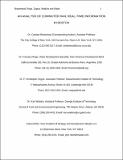An Analysis of Commuter Rail Real-Time Information in Boston
Author(s)
Brakewood, Candace; Rojas, Francisca; Watkins, Kari; Robin, Joshua; Zegras, P. Christopher
DownloadZegras 10-25-2014 Brakewood et al Final Manuscript.pdf (455.1Kb)
OPEN_ACCESS_POLICY
Open Access Policy
Creative Commons Attribution-Noncommercial-Share Alike
Terms of use
Metadata
Show full item recordAbstract
Prior studies have assessed the impacts of real-time information (RTI) provided to bus and heavy rail riders but not commuter rail passengers. The objective of this research is to investigate the benefits of providing commuter rail RTI. The method is a three-part statistical analysis using data from an on-board survey on two commuter rail lines in the Boston region. The first analysis assesses overarching adoption, and the results show that one-third of commuter rail riders use RTI. The second part conducts difference of means tests and regression analysis on passenger wait times, which reveals that riders’ use of RTI is correlated with a decrease in self-reported “usual” wait times. The third part analyzes 12 quality-of-service indicators, which have a limited relationship with RTI utilization. The results suggest that the benefits of commuter rail RTI are modest. Despite this, many commuter rail riders choose to use this new information source, which has important implications for transit managers considering deploying RTI systems.
Date issued
2015-03Department
Massachusetts Institute of Technology. Department of Urban Studies and PlanningJournal
Journal of Public Transportation
Publisher
University of South Florida
Citation
Brakewood, Candace, Francisca Rojas, Christopher Zegras, Kari Watkins, and Joshua Robin. “An Analysis of Commuter Rail Real-Time Information in Boston.” JPT 18, no. 1 (March 2015): 1–20.
Version: Author's final manuscript
ISSN
1077-291X
2375-0901